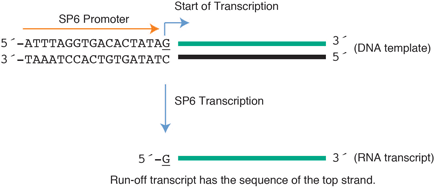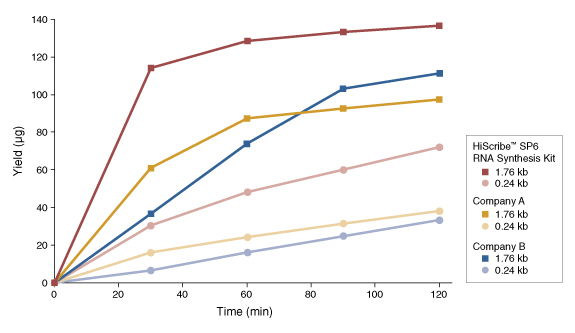Control Reaction The SP6 control template is a linearized plasmid containing the
Cypridina luciferase (CLuc) gene under the transcriptional control of the SP6 promoter. The size of the run-off transcript is 1.76 kb. The control reaction should yield ≥ 80 µg of RNA in 2 hours.
If the control reaction is not working, there may be technical problems during the reaction set up. Repeat the reaction by following the protocol carefully; take every precaution to avoid RNase contamination. Contact NEB for technical assistance.
The control plasmid pCLuc-SP6 sequence can be found within the DNA Sequences and Maps Tool. The pCLuc-SP6 control template is generated by linearizing the plasmid with XbaI.
Low Yield of Full-length RNA
If the transcription reaction with your template generates full-length RNA, but the yield is significantly lower than expected, it is possible that contaminants in the DNA template are inhibiting the RNA polymerase, or the DNA concentration may be incorrect. Alternatively, additional purification of DNA template may be required. Phenol:chloroform extraction is recommended (see template DNA preparation section).
Low Yield of Short Transcript
High yields of short transcripts (< 0.3 kb) are achieved by extending incubation time and increasing the amount of template. Incubation of reactions up to 16 hours (overnight) or using up to 2 μg of template will help to achieve maximum yield.
RNA Transcript Smearing on Denaturing Gel
If the RNA appears degraded (e.g. smeared) on a denaturing agarose or polyacrylamide gel, the DNA template is most likely contaminated with RNase. DNA templates contaminated with RNAse can affect the length and yield of RNA synthesized (a smear below the expected transcript length). If the plasmid DNA template is contaminated with RNase, perform phenol:chloroform extraction followed by ethanol precipitation. Dissolve the DNA in nuclease-free water (see template DNA preparation section).
RNA Transcript of Larger Size than Expected
If the RNA transcript appears larger than expected on a denaturing gel, template plasmid DNA may be incompletely digested. Even small amounts of circular DNA can produce large amounts of long transcripts. Check the template for complete digestion on an agarose gel compared to an uncut plasmid sample. If undigested plasmid is confirmed, repeat the restriction enzyme digestion.
Larger size bands may also be observed when the RNA transcript is not completely denatured due to the presence of strong secondary structure.
RNA Transcript of Smaller Size than Expected
If denaturing gel analysis shows the presence of smaller bands than expected, it is most likely due to premature termination by the polymerase. Some sequences which resemble the SP6 RNA Polymerase termination signal may cause premature termination. For GC-rich templates, or templates with secondary structure, incubation at 42°C may improve the yield of full-length transcript.
If premature termination of transcription is found in high specific activity radiolabeled RNA probe synthesis, increase the concentration of the “limiting nucleotide”. Additional unlabeled limiting NTP can be added to the reaction to increase the proportion of full-length transcript, however the improvement in yield of full-length product will compromise the specific activity of the probe.



